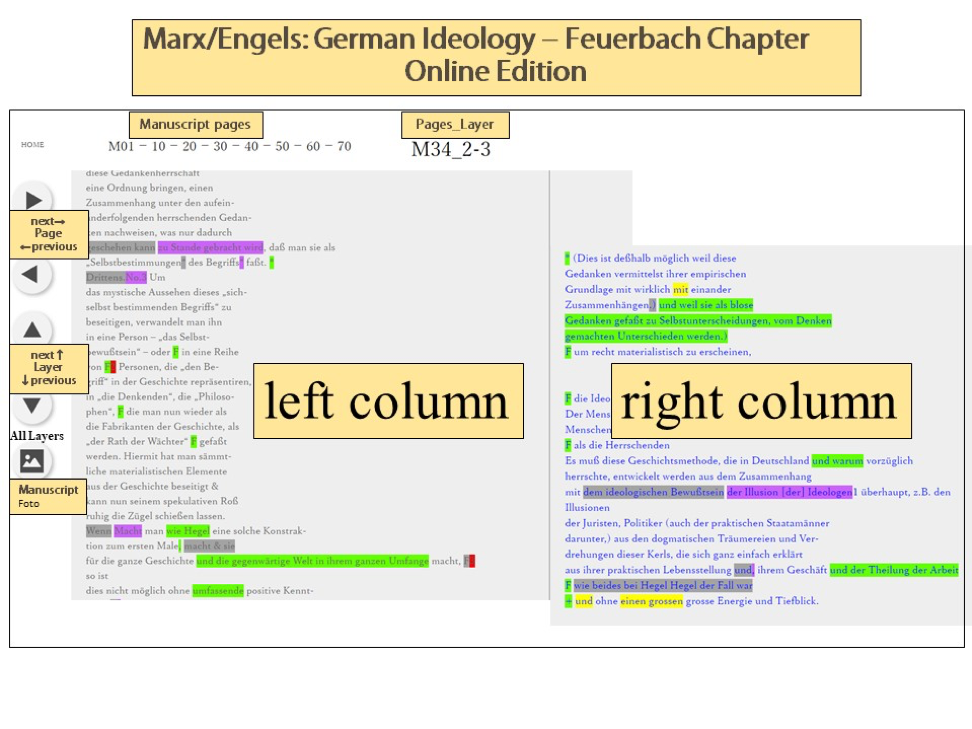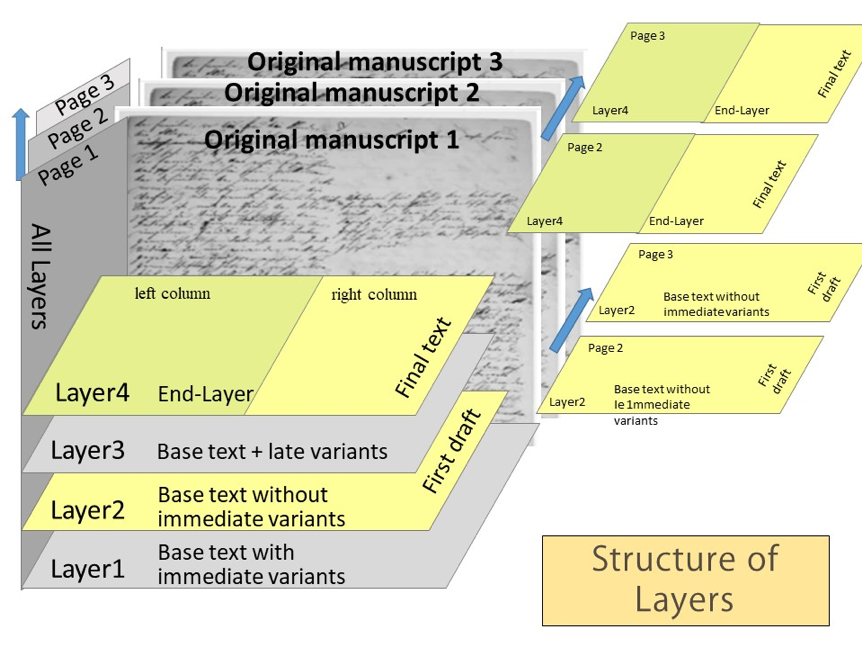How to Use
The online editions page looks like so.
The original manuscript consists of two parts, left and right column. On the monitor you can see the left column and a part of the right column, which you can see by moving the screen to the right.
On the left side are the buttons, each of which has a specific function.
Use the Up and Down arrow buttons to go to the next or previous layer.
Then you read the pages as follows:
M01-1 --> M01-2 --> M01-2 -->M01-3-1-->M01-3-2-->M01-3-3-->M01-3-Ende-->M01-4-->M01-3-ALL
And the Right and Left arrow buttons to go to the next or previous page.
You can also find two other buttons on the left side, "All Layers" and “Photo” button, with which you can see the photo image of the original manuscript at any time.
At the top are the page number and the number of the layer you are currently reading.
Each layer can not only be read up or down, but also some layers can be read through the pages, namely Layer 1, Layer 2, Layer 3 Ende, Layer 4 and All Layer.

The symbols and colors used in online edition:
For the 1st Layer:
① Deleted text of immediate variants is in yellow.
② Inserted (i.e. supplementary) text of immediate variants is in green.
③ Words marked with @ are the immediate variants that the online editors have confirmed independently from the editors of MEGA② I/5.
For the 3rd Layers:
① Deleted text of late variants is in grey.
② Replaced text of late variants is in pink.
③ Inserted (i.e. supplementary) text of late variants is in green.
The green color is also used sparingly in the first layer.
Words or parts that the editors could not decipher are in red.
Engels’and Marx's writings in the right column are in blue font.
In addition, we distinguish between two fonts.
The font Arial is for Marx’s handwriting.
We typically use Times New Roman.
We have taken the following points into consideration:
(1) Readers should be able to follow the working processes between the manuscripts’ left and right columns in detail. Therefore, visitors to our page should be able to look at these columns simultaneously. They can also take a photo of the original manuscript and compare texts this way. The break points in the online edition correspond to those in the manuscripts, making it easy for visitors to compare our online edition to the original. In these ways, our online edition differs from the MEGA② I/5.
(2) The base text of the manuscript is different from the text published in the MEGA② I/5 printed edition. The latter has been improved by Marx and Engels. To reproduce the base text, the editors of this online edition did the following:
[1] deleted the text that was written in the right column;
[2] returned the replaced text to the original;
[3] re-inserted the deleted text;
[4] deleted the inserted text.
The resulting text, the base text of the “Feuerbach” manuscript, is “Layer 2.” If we add the elements of the deleted parts of the immediate variants to “Layer 2,” we are left with “Layer 1.”
(3) Engels’ first improvement to the base text. “Layer 3-1” (left and right columns) contains these improvements.
(4) The reproduction of Marx’s editing. Marx edited both the left and right columns. All edits by Marx are displayed in the “Arial” font, and in the right column they are blue-colored. “Layer 3-2 (left and right)"” contains Marx’s improvements.
(5) The reproduction of the Engels’ editing follows (4) and is contained in Layer 3-3 (left and right columns).
In addition, we included an “End-Layer” (Layer 4) and “All layers” in our online edition. The editing process of The German Ideology repeated the deletion, substitution, and supplementation of text in the “Feuerbach” manuscripts. The places in the text which changed in the course of editing or were supplemented and were not deleted can be found naturally in the “End-Layer” (Layer 4) – that is, in the final text of the manuscript. However, this layer does not contain the deleted parts of the text. Therefore, our online edition also contains a special layer which we called “All layers.” This layer contains everything which was deleted during the editing process. This layer is supposed to resemble the text image of the original manuscript.
